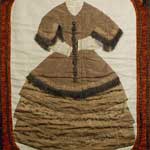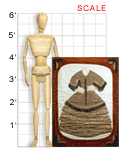From the collection of:
Kentucky Museum of Art and Craft || VAM Home
Alma Lesch (Kentucky, 1917-1999)
JUDY O’GRADY, 1979
Quilted, appliquéd, and pieced fabric; 48" X 27"
Kentucky Museum of Art and Craft
Alma Lesch earned her reputation as a pioneer in the contemporary craft movement by combining traditional quilting techniques with her own innovative stitchery and by incorporating found objects to create complex narrative works. Judy O’Grady is an example of one of her signature fabric portrait collages. Lesch was inspired to create this piece and The Colonel’s Lady after reading the poem “The Ladies” by Rudyard Kipling.
About the Artist
Alma Wallace Lesch was born in McCracken County, Kentucky. She began working with fiber at the age of 5, stitching panels for a quilt that she completed at the age of 12. Even before attending school, Lesch practiced embroidery with her mother and grandmothers. By the time she was in grade school, she was creating her own textile objects and sewing her own clothes.
After earning a bachelor’s degree from Murray State University and a master’s degree in education from the University of Louisville, Lesch made a career teaching art and textiles. She taught elementary school and later taught at the Louisville School of Art and U of L.
Much of Lesch’s work in the 1960s reflected Biblical and rural themes. Toward the end of the decade, she began to incorporate discarded and antique clothes and accessories into her stitchery pieces. She quickly became nationally recognized, then internationally in 1968, when the Kunstegewerb-museum in Zurich included her work in the exhibition “The Art of Collage.” In 1970, two of her works were included in a national touring exhibition, “Objects, U.S.A.,” that gained recognition for contemporary crafts as part of the fine art world. In 1974, the World Craft Council recognized her as a Master Craftsman. She received a Kentucky Governor’s Award in the Arts for Lifetime Contribution to the Visual Arts in 1987, and in 1996 she was honored as the first recipient of the Rude Osolnik Award for lifetime achievement in craft from the Kentucky Museum of Art and Craft.
Lesch inspired generations of artists, both at home in Louisville and through workshops she gave across the United States. Her works are in numerous private and museum collections, including the American Crafts Museum in New York.
Classroom Ideas
Discussion: Read “The Ladies” by Rudyard Kipling. Does Judy O’Grady capture the character Kipling has written about? If so, how? Even though Lesch’s “character” does not have a face or body, this work is considered a type of portrait. Do you think it is an effective one? Why or why not? Think about your favorite piece of clothing or outfit. What do you think it says about you?
How would you classify this work? Would you consider it collage? How does it compare to the contemporary quilts shown in the Museum of the American Quilter’s Society gallery of the Kentucky Virtual Art Museum?
Activities: Using markers, crayons, and/or colored pencils, draw a person on a large sheet of paper, using as much detail as possible. You can draw yourself, a friend or family member, or a fictitious character. Your drawing should include objects that represent the person being portrayed. For example, if the person you choose is a world-class skier, you might draw him or her wearing a winter jacket, a hat, and gloves. More visual clues could be added by including a pair of skis, some snowy mountains, and a ski lift. Get with a partner and talk about the people the two of you have drawn. If you realize during your discussion that you have left out interesting details in your drawing, take a minute to add them to your portrait.
Cut out pieces of old clothing and fabric and arrange them on a piece of construction paper or poster board. Use other items, like buttons or beads, to add details to your piece. Remember that your portrait shouldn’t include head, hands, or feet. Consider balance and shape as you plan your composition.
Links
Read the article Textile Artist Alma Lesch Remembered as a Pioneer on the Kentucky Museum of Art and Craft web site.
[www.kentuckyarts.org/alma_lesch.htm]
See other works by Alma Lesch at the Kentucky Library and Museum and the Speed Art Museum.
[www.wku.edu/Library/onlinexh/kwa/lesch.html]
[www.speedmuseum.org/lesch_n.html]
Read Rudyard Kipling’s “The Ladies” at the Poetry Lovers Page.
[www.poetryloverspage.com/poets/kipling/ladies.html]



